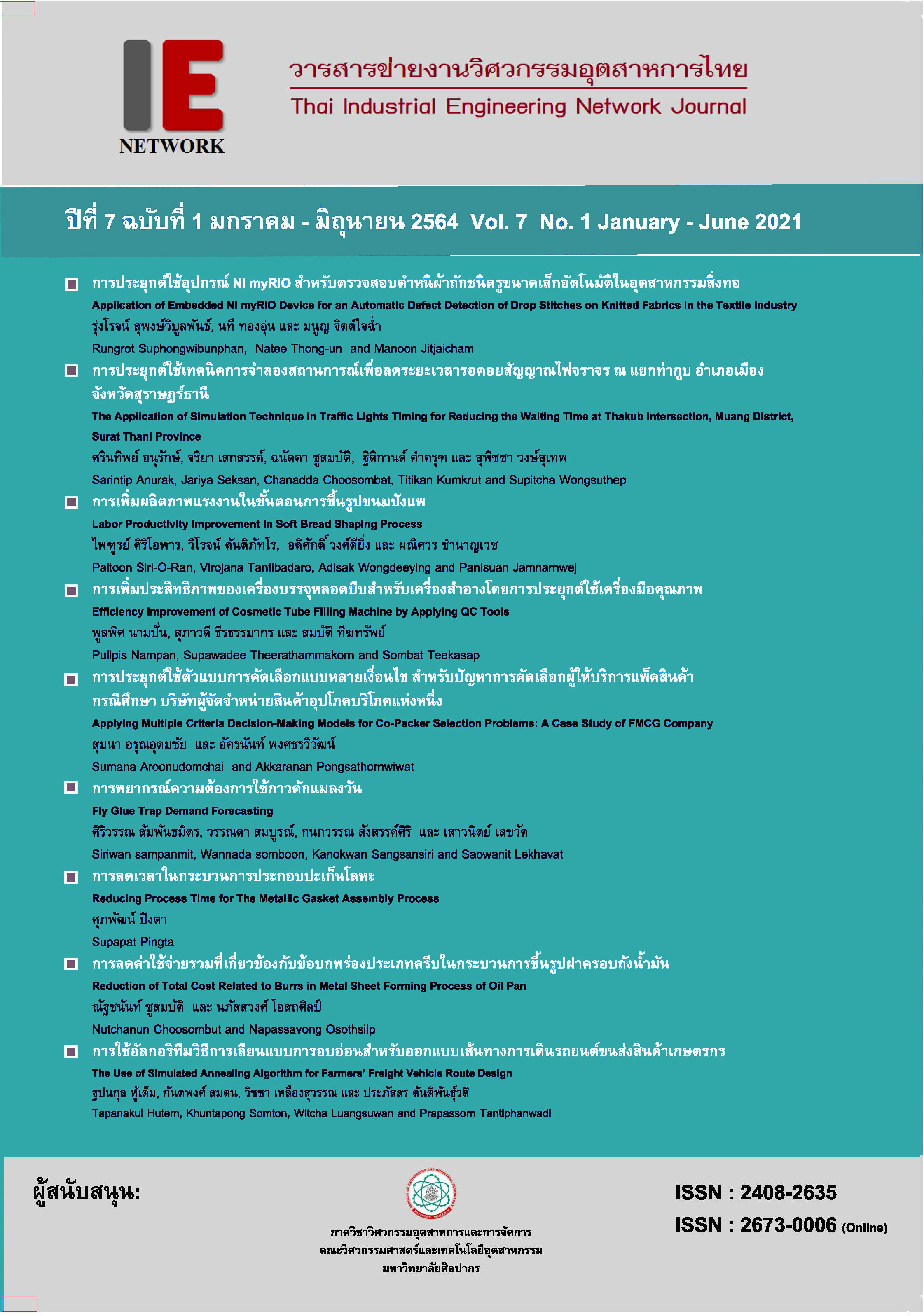Efficiency Improvement of Cosmetic Tube Filling Machine by Applying QC Tools
Main Article Content
Abstract
The aim of this research is to study the causes of damage in tubes used for cosmetic products and to improve the cosmetic filling process of the tube filling machine by using quality control tools for increasing manufacturing efficiency. The studies consist of studying the manufacturing processes of the cosmetic product that uses oval-shaped tube using the principles of 3GEN, waste data collection using inspection sheets, prioritization of problems using the Pareto chart, evaluating the causes of problem using the fishbone chart, and proofing the causes via problem analysis techniques of 6 questions (5W1H). A duplicate of full factorial design of three factors (8 experiments) was carried out (total is 16 experiments) to optimize the settings of the machine that yields the least waste. The results showed that the factors involving with filling machine and impacting on the tube are filling speed and the tube support settings. After optimizing the filling machine operation settings, more than 90 percent of the waste was reduced (from 2.14 to 0.09 percent). Both capability indices of the production processes, the index of long-term process potential (Pp) and the index of long-term process performance (Ppk), after the optimization were greater than one indicating the increased capability of the production processes. In Addition, the measured process efficiency value after improvement was dropped from 30.67 to 21.82 hours, a substantial increase of about 71 percent.
Article Details
บทความ ข้อมูล เนื้อหา รูปภาพ ฯลฯ ที่ได้รับการตีพิมพ์ในวารสารฯ ถือเป็นลิขสิทธิ์ของวารสารฯ หากบุคคลหรือหน่วยงานใดต้องการนำทั้งหมดหรือส่วนหนึ่งส่วนใดไปเผยแพร่ต่อหรือเพื่อกระทำการใดๆ จะได้รับอนุญาต แต่ห้ามนำไปใช้เพื่่อประโยชน์ทางธุรกิจ และห้ามดัดแปลง
References
[2] วีรพงษ์ เฉลิมจิระรัตน์. การแก้ปัญหาแบบ QC
วิธีการแก้ปัญหาในงานตามแบบฉบับญี่ปุ่น.
(พิมพ์ครั้งที่ 10). กรุงเทพฯ: สมาคมส่งเสริม
เทคโนโลยี (ไทย-ญี่ปุ่น). 2548.
[3] จุไรรัตน์ ลาธุลี. การลดของเสียในกระบวนการผลิตสวิตซ์ควบคุมกระจกมองข้างไฟฟ้า ด้วย กิจกรรมกลุ่มคิวซีซี. (วิทยานิพนธ์ปริญญาวิศวกรรมศาสตรมหาบัญฑิต). ชลบุรี: มหาวิทยาลัยบูรพา. 2559.
[4] จิราพิสิฐ ไชยอารีกุล. การลดเวลาสูญเปล่าจากการเปลี่ยนผลิตภัณฑ์ของเครื่องบรรจุหลอดอัตโนมัติ. (วิทยานิพนธ์ปริญญาวิศวกรรมศาสตรมหาบัณฑิต). กรุงเทพฯ: มหาวิทยาลัยเทคโนโลยีพระจอมเกล้าธนบุรี. 2550.
[5] ปิยมน โกศลชัย. การลดปริมาณของเสียใน
กระบวนการผลิต เพื่อเพิ่มประสิทธิภาพ และ
ลดต้นทุน กรณีศึกษา บริษัท ผู้ผลิตถุงบรรจุนม จำกัด. (วิทยานิพนธ์ปริญญาวิทยาศาสตร
มหาบัณฑิต). ชลบุรี: มหาวิทยาลัยบูรพา. 2559.
[6] อฐิลักษณ์ เตียวติ, บุญชัย แซ่สิ้ว และศุภชัย วรรัตน์. การปรับปรุงกระบวนการผลิตเพื่อลดของเสียในกระบวนการผลิตโดยใช้หลักควบคุมคุณภาพ 7 อย่าง (7QC Tool) กรณีศึกษาการผลิตขึ้นรูปพลาสติกด้วยระบบสุญญากาศ. การประชุมวิชาการช่วยงานวิศวกรรมอุตสาหกรรม 30-31 ตุลาคม 2557. สมุทรปราการ .2557.
[7] ศุภวัชร์ เมฆบูรณ์และจีรวัฒน์ ปล้องใหม่. การลดของเสียในกระบวนการผลิตโพลิเมอร์โซลิด คาปาซิเตอร์. วิศวกรรมสารเกษมบัณฑิต, 7(1), 105-123. 2560.
[8] ปรัชญา พละพันธ์. คู่มือวิเคราะห์และจัดการ
ข้อมูลสถิติด้วย Minitab ฉบับมืออาชีพ (พิมพ์
ครั้งที่ 1). นนทบุรี: ไอดีซี พรีเมียร์. 2560.
หน้า 167.
[9] มงคล เหล่าวราพันธุ์. ชัชวาล มงคล. สุธี ประ
จงค์ศักดิ์. ลินดา นาคโปย. การปรับปรุง
ประสิทธิภาพกระบวนการผลิตสินค้าสีสเปรย์.
วารสารวิจัยและพัฒนาวไลยอลงกรณ์ในพระ
บรมราชูปถัมภ์ สาขาวิทยาศาสตร์และ
เทคโนโลยี. ปีที่ 1 ฉบับที่ 3(กันยายน-
ธันวาคม). 2561 หน้า 143-152.


